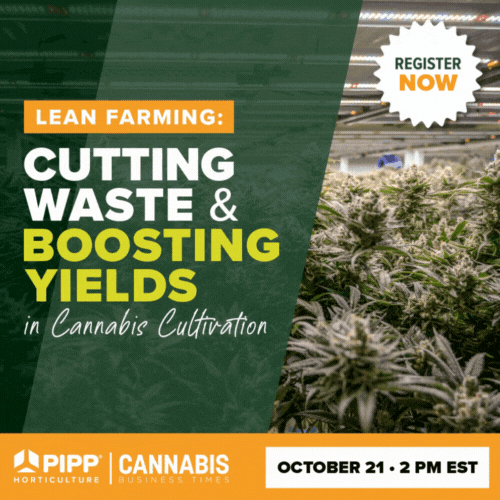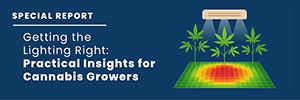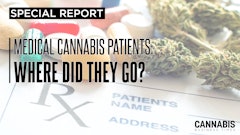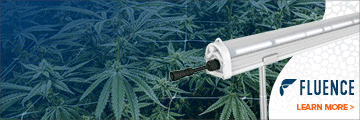
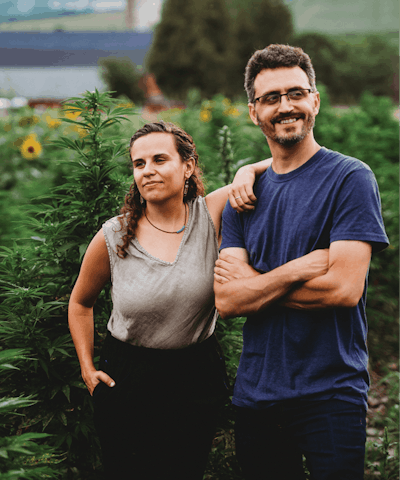
Images by Allison Marie Photography
When Allan Gandelman and Karli Miller-Hornick met at a six-month sustainable agriculture program in 2010, they instantly connected over their shared passion for local produce.
Gandelman, a former social studies teacher, pursued the program because he realized a lack of fresh food was a major obstacle for many of his students. He left his teaching job and launched Main Street Farms in Cortland, N.Y., to supply organic vegetables like carrots, cabbage, beets and greens through a Community Supported Agriculture (CSA) program at several farmers markets.
A few years later, Miller-Hornick joined Gandelman’s team to help scale the operation, more than tripling its CSA memberships from 100 to over 350. Then, around 2016, at the height of the farm’s busiest season yet, Gandelman developed chronic Lyme disease—triggering debilitating pain and arthritis that impeded his ability to manage the farm.
“My doctor kept trying to prescribe me painkillers, but I was still driving the tractor and running the farm, and I knew I couldn’t do that on opioids,” Gandelman says. “Then a friend in Colorado sent me a bottle of CBD [cannabidiol] oil, so I started taking that and slowly feeling the effects. After a few months, most of my pain was gone.”
As CBD became part of his routine, Gandelman found an opportunity to introduce hemp into his crop rotation. When New York legalized its industrial hemp program beyond the initial pilot research phase, Gandelman received one of the first few licenses to produce and process hemp to extract CBD. Recognizing the new crop as a way to diversify the farm, Gandelman and Miller-Hornick founded New York Hemp Oil (NYHO) in 2017—setting a foundation that would eventually support a portfolio of hemp brands, including their main product line, Head & Heal. As president of both companies, Gandelman manages cultivation and extraction, while CEO Miller-Hornick oversees sales and marketing.
“We were looking for something to build a more sustainable long-term business and keep our farm employees employed year-round through a value-added product,” Miller-Hornick says, “and hemp was the answer for us.”
Starting Small
By the time they received their license in the fall of 2017, the growing season had already passed. To ease into the nascent market, they started sourcing raw CBD oil from Colorado to make their first hemp product: a 600-milligram CBD tincture.
“We already had a commercial food processing kitchen, which at the time was the [only] requirement for extraction,” Gandelman says. “We started making our own tinctures in our commercial kitchen and then bringing them to the farmers market to see if anyone would even buy them.”
At farmers markets, Miller-Hornick spent time educating consumers about CBD, leveraging Gandelman’s story along with her personal experience taking CBD oil to help with symptoms of seasonal depression and anxiety. “We realized that we had something because the customers would come back with their friends and family,” she says. “Before we knew it, the sale of CBD was surpassing the sales of our vegetables.”
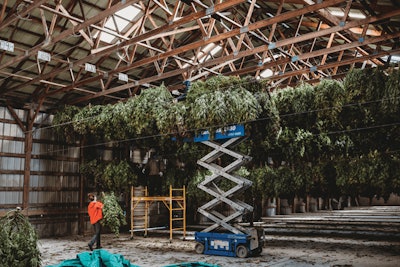
Starting small was the key to the company’s success. “It’s all about proving your concept first,” Miller-Hornick says. “We validated the product before we made a massive shift at the farm to make sure this was something that people wanted.”
This early validation made Gandelman confident there would be a strong market for the company’s products, and he proceeded to plant his first hemp crop in 2018.
Finding Good Genetics
Compared to the relatively easy task of ordering vegetable seeds, Gandelman quickly realized that finding quality hemp genetics required much more diligence. “We traveled all over the country visiting seed breeders, seeing their operations, buying samples and trialing them to see what worked,” he says.
Bolstered by a longstanding agricultural research partnership with nearby Cornell University, Gandelman formalized his genetic research with scientific testing to validate his trials, gathering data about cannabinoid content, planting dates and disease resistance across varieties. “We were doing some research with them a long time ago on the vegetable side,” he says, “so once [New York] established the hemp program, I already had a lot of good Cornell connections. It’s great to confirm what we’re doing with actual data.”
For the 2018 growing season, Gandelman planted 10 acres of both feminized and non-feminized hemp seeds. “We quickly learned that using non-feminized seeds was a no-go because we were [finding] males every day and pulling half our plants,” he says.
Through multiple trials, Gandelman narrowed down the best-performing feminized cultivars from Oregon CBD, which are certified organic and non-GMO. These certifications were critical to Gandelman’s goal to have his products labeled organic.
“From day one, I wanted to have the highest-quality product possible,” says Gandelman, whose products are U.S. Department of Agriculture (USDA) Certified Organic, non-GMO and kosher, “so we had to make sure that our seed breeders were in compliance with organic standards.”
Although he continues to trial new varieties every year while conducting ongoing research with Cornell, Gandelman prefers strains from Oregon CBD. Their seeds make up more than half of the 15 varieties he’s growing this year.
Farming Tradition
When it came to growing hemp, Gandelman relied on his previous vegetable farming experience. “We had all the equipment and the infrastructure we needed. We also have a really experienced farm team,” he says. “Without those, we would have failed instantly.”About four weeks after starting hemp seeds in the greenhouse in early May, Gandelman uses the farm’s water wheel transplanters to move the seedlings to the field. “We had to modify some of our planting equipment to get the right spacing,” he says, “because the vegetable spacing is so tight—three rows, usually 12 inches onset—and hemp [needs] 5 feet in between plants.”
Aside from watering young transplants with drip or overhead irrigation, Gandelman primarily relies on rain for the duration of the season. To minimize the need for inputs, Gandelman uses his own farm’s soil. “We cover crop with nitrogen-fixing legumes before the hemp crop … and we apply composted chicken manure to our fields for fertilizer pre-planting,” he says. Gandelman says he also plants sunflowers to attract beneficial insects and help separate and distinguish the hemp varieties he grows.
Regular crop rotations help reduce pests and disease throughout the 200-acre farm, where he typically grows about 30 acres of vegetables and 30 acres of hemp each season.
Depending on the strain, Gandelman harvests hemp crops between early September and early October. The harvesting process differs, depending on whether the harvest will be sold as dried flower or extracted for full-spectrum oil (which accounts for the majority of products).
First, to harvest hemp flower, Gandelman explains, “we’re walking through the field and finding the best tops of the plants, hand-harvesting them, and then bringing them into a climate-controlled drying room, where we let them dry for about two weeks and then trim them.”
With the remaining crop destined for extraction, Gandelman says, “we are hand-harvesting the whole plant and then hanging it upside down to dry. From there, we proceed to buck. We built custom machines that can [buck] an entire plant and just pull all the leaves and flowers off at once, and then it kicks the stem out on the other side.”
Although they use machines to help buck and trim, the actual harvesting is all done by hand. Early on, when they tested the farm’s mechanical harvesting and drying machines, they learned precisely how these processes impacted the end product.
“When we tested it, we found that we lost over 30% of the cannabinoid and terpene content when it was harvested with a combine and a mechanical dryer,” says Miller-Hornick. “While that was way more efficient—what took two weeks took 15 minutes—the quality of the product really suffered, because if you take a burnt flower out of a dryer and then put it in oil, you’re going to get that flavor in the oil. So, what we do here is a labor of love; we harvest every plant by hand and hang-dry everything to slowly cure.”
Extracting Innovation
As Head & Heal products gained popularity, the company quickly outgrew the small ethanol extraction facility built during its first hemp growing season. So, Gandelman purchased an old lumberyard in downtown Cortland and converted part of it into a 5,000-square-foot extraction and manufacturing space, which meets current Good Manufacturing Practices (GMP), he says. To achieve organic certification of the end products, the facility uses an organic cane sugar ethanol extraction process.
“If we’re growing organically and putting this much love and effort into the plant, we wanted to capture as much of that essence in the finished product as possible,” Miller-Hornick says. “Through the different [extraction methods] that we tested, ethanol gave us the highest cannabinoid and terpene content for our full-spectrum oil.”
The company does most of its own extraction and formulation on-site and partners with a local company that employs people with disabilities to bottle its products. A few exceptions include certain products, like dog treats, which are formulated offsite, and rare cannabinoids, like cannabinol (CBN), which are extracted offsite.
“We launched CBG [cannabigerol] and CBN [tinctures] about a year ago, and we were surprised how quickly those ended up in our Top Five,” Miller-Hornick says of the company’s most popular products. “Now we’re getting requests to have those [cannabinoids] in other formats, like gummies, which we’re hoping to launch this winter.”
Since debuting its first bottle of CBD oil at a farmers market, Head & Heal has “built the brand by listening to what customers were asking for,” Miller-Hornick says. After the original tinctures came topicals, capsules, dog treats, bath products, and other formulations currently comprising about 25 stock-keeping units (SKUs). “We have a private Facebook group where we’re constantly polling our customers, and we have an Innovation Club where we’re sending out surveys to ask our customers about the next product they want," she says.
Although farmers markets remain a critical customer touchpoint for the Head & Heal brand, most product sales come through the company’s website, followed by retail sales at about 400 pharmacies and natural health food stores around the country.
Most recently, Head & Heal has been working on water-soluble cannabinoid beverage research and development in partnership with two well-known nearby craft beer producers.
The company hopes to launch organic CBD and CBG beverages this fall under the brand name Tune. “Usually when we launch a product, we launch 100 units at the farmers market,” Miller-Hornick says, “but when we launch these beverages, the initial run will be 20,000 units. We’re excited to continue to invest in product development and [understand] what our [customers'] wants and needs are.”

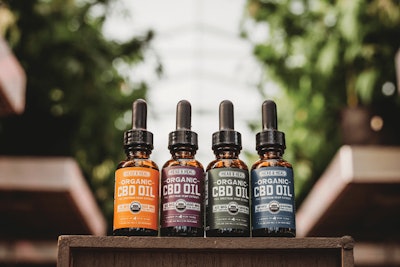

Processing for Private Labels
Ever since NYHO opened one of the state’s first hemp extraction facilities, Gandelman says, “we’ve had other farms calling and asking us if we would do their processing for them, because building a processing facility is expensive and requires so much knowledge.”
Recognizing another opportunity to expand the farm’s offerings, Gandelman added services like extraction, custom product formulation, and bulk supply of hemp extracts, distillates, isolates and water-soluble CBD for private-label brands. Although Head & Heal product sales comprise roughly 75% of the company revenue, according to Miller-Hornick, these private-label services help diversify the business while supporting other hemp producers.
“Ultimately as a small farmer, the key to our approach is to diversify our income,” Gandelman says. “As a small business, we also try to take care of other small businesses to help them succeed as much as possible.”
Early on, the company sold a lot of bulk oil to supply other brands. But as the CBD market swelled with oversupply, driving down prices and pushing many out of the hemp industry, Gandelman quickly learned the importance of locking in buyers before planting hemp.
“We had to deal with oversupply because we were creating bulk oils for customers that basically disappeared or went out of business when the market dried up,” he says. “Basing your business off of that kind of instability is scary, but luckily, raw CBD oil and distillate are very shelf-stable, so now we have a good amount of inventory that we’re just sitting on, waiting for the prices to rebound.”
To combat the oversupply, like many cultivators, Gandelman scaled back his hemp operation this year, only planting 5 acres compared to the 30-40 acres he planted in previous seasons. Although private-label processing services are still an important piece of the company’s diversification strategy, that business depends largely on “market forces that you can’t control,” he says. “More of our hemp goes to our products than to private label, purposefully, so that we can control our brand.”
Pushing the Industry Forward
Gandelman’s mission to help other hemp farmers extends far beyond his own facilities. Soon after entering the industry, he established the New York State Cannabis Growers & Processors Association to advocate for regulations that support producers across the Empire State. This industry organization, which currently has about 140 members, works closely with state legislators like New York Assemblywoman Donna Lupardo, who has been a driving force behind the state’s hemp program.
Lupardo agrees the association has played an important role in advancing the state’s cannabis and hemp industries. “They have educated and mobilized many growers and processors into an effective advocacy organization,” says Lupardo, chair of the assembly agriculture committee. “They present a unified voice for their members and act as a valuable resource for legislators, economic developers and others.”
The association has lobbied on several key issues impacting hemp producers, contributing to Lupardo’s hemp extracts bill that was signed into law in 2019. According to Lupardo, the bill:
- establishes stricter CBD labeling standards for consumer production;
- creates more robust manufacturing standards that require processing facilities to be GMP certified; and
- allows the sale of hemp flower as well as CBD-infused food and beverage products.
“As we develop this new commodity, we want to make sure that our small farmers get all the advantages that they can because they represent an important part of New York’s agricultural economy,” Lupardo says.
Committed to protecting farmers and preventing “large out-of-state corporations coming in and gobbling up the market,” Gandelman says, the association played a prominent role in crafting New York’s Marijuana Regulation and Taxation Act—which includes the goal of giving 50% of licenses to social equity applicants, including financially distressed hemp farmers.
Miller-Hornick and Gandelman plan to pursue an adult-use license to further diversify their operation while continuing to grow hemp alongside traditional produce. As the state and federal cannabis markets continue to evolve, they expect this diversification strategy to bolster the farm’s long-term sustainability.
“Persistence and agility have been extremely important to us, whether it’s changing laws or changing customer attitudes,” Miller-Hornick says. “Being open to changing our business model and changing directions as the industry ebbs and flows has been key to our success.”

